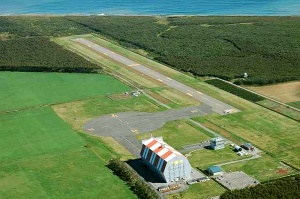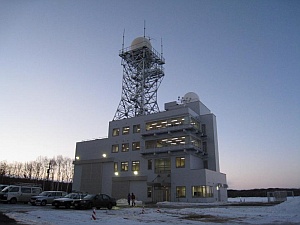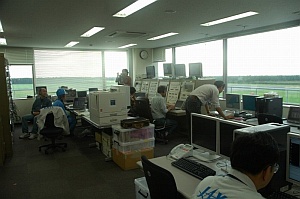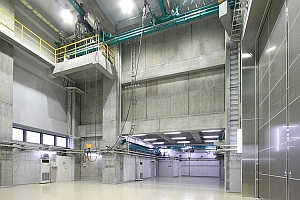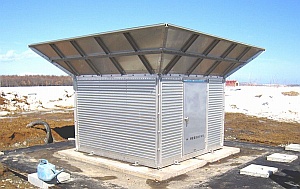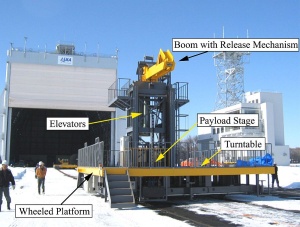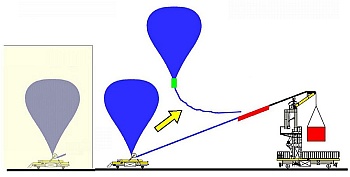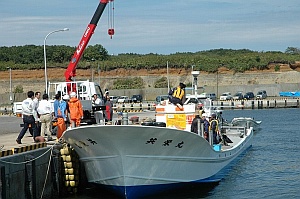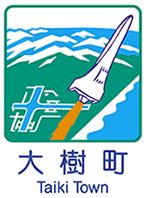
The Taiki Aerospace Research Field (TARF) (formerly known as the Taiki Multi-Purpose Aerospace Park) is located in a broad flat plain that spreads out for 30km along the coastline of the eastern shore of the Hokkaido Island in the northern part of Japan. It was established in early 90's decade under a plan to improve the land use carried out by the town of Taiki, a small settlement with an average population of 7000 people. The initial land reclamation and acquisition took place in 1993 and the next year was started the construction of the first hangar and the old runway. In October of 1995, was the formal inauguration of the Park, which covers a total area of 47 hectares.
In 1997 the National Aerospace Laboratory (now part of JAXA) signed an agreement with the local authorities to use the facility to perform aerospace-related experiences. It was the starting point of a long lasting cooperation effort between the town of Taiki, Hiroo-gun in Hokkaido and JAXA to carry out an extensive program of experiments. By that time Taiki was known as the best site to host such tests which is reflected even in the town's shield (image at left).
In 2000 great improvements were carried out to the site with the addition of a paved landing strip measuring 1000 meter long and 60 meters wide. Also a flight test building was constructed to control the operations of test aircraft and to perform some data processing.
At that time, under the aegis of the Stratospheric Platform (SPF) project devoted to built an airship capable of stratospheric flight, a big hangar was erected to offer shelter for the airship as can be seen in the picture at left. The structure have an heptagonal prism shape measuring 30 meters wide, 83 meters long and 35 meters high, and counts in front of it with a paved circular field measuring 140 meters of diameter known as the handling area. Also a flight control tower, and a full weather observation facility were built. Station-keeping flight tests of the SPF airship were performed in Taiki and sourroundings between 2001 and 2004.
Other projects were carried out too at the TARF including aerial experiments involving the use of airplanes and helicopters. Also the space program used the site for making surface tests of the SELENE project as well high altitude fall tests and even static rocket motor firings and rocket launch experiments, the later carried out by Hokkaido University.
Context that lead to the creation of the new facility
By 2005, the Japanese balloon program faced some challenges. As the science payloads became progressivelly bigger and heavier by logical consequence they required much larger balloons to be flown. This fact complicated the operations due to the intrinsec limitations of the Sanriku Balloon Center (SBC) the main launch base of the program since 1975.
As the center was located in the middle of montanious terrain, sudden wind gusts during balloon inflation operations were not uncommon. This affected a bit the launch operations of medium and small balloons but definitivelly were a risk for the launch of the big balloons needed for the new payloads. Additionally the length of the launching pad was some what limited. Althought in recent years was possible to extend it to 160 meters of longitude, that was the ultimate physical limit, being too small for the adequate handling of large flight trains exceding 200 meters of longitude.
Also on regard of safety issues, there were big concern to allow the launch of heavier payloads. In fact, the balloons once in the air and before reaching the secure fly zone over the Ocean passed over a populated area, several roads, and a railway track which was considered a potential risk.
But the worst factor to consider was also the less controllable of all: probably due to the global warming the once predictable westerly Jet Stream showed in the last years a strong tendency to unstability, forcing delays and even cancellations in the planned campaigns.
Thus, in 2006, JAXA decided to move their balloon operations from Sanriku to Taiki. At first sight the Multipurpose Aerospace Park seemed to be ideal for the activity: it counted with big open spaces, it was sourrounded of very low populated areas and the local people were habituated to aerospace experiments. As the main project of JAXA at Taiki -the Stratospheric Platform Project- was over since March 2005, all the facilities, including the huge hangar used to shelter the airship, were available for the balloon activities.
On latest years the common flight scheme was the so called "boomerang" or "cycling" mission where a balloon released on the coast of the Pacific Ocean ascends up to 30 km, moment on which a signal is sent to vent some gas and stop its ascent, being picked up by westerly winds. After reaching a limit point to the east a command is sent to the balloon to release ballast to restart the ascent until reaching float altitude, moment on which the balloon is picked up by easterly winds that send it back to land. On this regard Taiki as located further north than Sanriku, offered more stability in regard the flow of the winds necessary for the realization of longer duration flights.
As was usual in balloon operations at the former base, two campaigns are planned to be conducted annually to coincide with the movements of inversion of winds in the stratosphere, the first of which occurring from mid-May to mid-June and the second from mid-August to mid-September. Also, if long flight times are not needed could be a brief opportunity to launch balloons in Summer time, something that was not possible to do at Sanriku because there it was a very rainy season.
New infrastructure
Decision was taken and by July 2007 while at Sanriku preparations were underway for the latests balloon launches before it's closure (that occured in September), the construction of the new Balloon Operation Building began at MAP.
The building (click on the left image for a detailed view) is a four-story structure devoted exclusivelly to balloon related operations. All floors are connected each other by stairs and an elevator and counts with more than twenty rooms including: a control room, a telemetry-command room, two payload assembly rooms, a conference room and several offices.
The flight's operative control is consolidated in a single environment (click on the right image for a detailed view) wich mean a great improvement from the former base because there all the flight systems were scattered in different parts of the Sanriku complex and even the telemetry antennas were located in nearby hills.
At the top of the building was constructed a tall steel tower to locate on top of it telemetry and command antennas. The height of the tower was determined by the need for the signal not be blocked by the nearby huge hangar, to avoid the influence of the sea surface reflection in long range communications with balloons but at the same time not to surpass the maximum height permited for such a structure by air safety regulations. On top of the tower lies a radome containing a maritime surveillance radar. As the balloons are flown over the Ocean and the payloads recovered from it, the radar is used to maintain a close monitoring on the ships that are navigating near the landing zone of the payloads to avoid any chance of collision. Also on the rooftop of the building lies another telemetry antenna used as a backup system.
On one side of the operations building, is stationed LASCOS (Low Altitude Space COmmunication System). This system consists of a mobile balloon tracking, receiving station and networks which can connect the balloon in flight with the Operations Building and a remote site as the Institute of Space and Astronautical Science (ISAS) in Kanagawa Municipality. Monitoring of balloon trajectory, telecommand transmission and telemetry data acquisition can be done from any computer terminal in any site through LASCOS. It was developed back in 1996 and have enough flexibility to adapt to even a foreign balloon station. The number of individuals necessary to operate its minimum being well suited to be used for long range tracking and balloon expeditions.
In the floor plant, are located two large rooms devoted to the integration of the payloads (image at left - click to enlarge) with direct access to the launching pad. The bigger assembly hall has two 10 meter high overhead cranes with a lifting capacity of 2 tons and the smaller one has one 4 meter high crane with similar capacity. The smaller hall serve as workshop too being installed several machine tools. Outside the building there is a non-magnetic calibration stage based in a turntable with an azimuth scale, for use by the scientific teams to prepare the geomagnetic compasses often used to monitor the payloads attitude during flight.
In order to monitor the balloon and the payload during the launch operations several surveillance cameras are installed all around the MAP. The real-time video images are distributed to each room in the operations building throught a closed circuit cable television network. Something similar occur with voice communication between the operational crew which is possible thanks to a multi-point headset-transceiver system carried by each staff member and boosted by several relay stations at various points in the MAP. Science data transmitted from the balloon in flight is received by the two telemetry antennas and can be distributed to several rooms in the building using a data distribution network. The hangar is also connected to this science data network via optical fiber.
A major broadband LAN network is established inside and outside the operations building and is divided in two logical subnetworks: one for the balloon operation computer system, and the other for the science group. Both subnetworks are connected to Internet through a high speed link (5 Mbps) and secured by firewalls.
In case of a power outage during a mission, the operation building counts with a backup generator which can provide up to 55KVA of power, enough to maintain alive the minimum operative functions.
Several meteorological equipments were already installed in the TARF for the Stratospheric Airship project and others were transferred from their original locations in the Sanriku balloon base.
To obtain information on lower atmospheric wind condition there is a Doppler sodar (Image at right), which provides the vertical profile of wind speed and wind direction from the ground up to an altitude of around 1 km, which was transferred from Sanriku and joined the already existent Doppler sodar which can measure the wind profile between 30m to 400m over the ground. For mid-tropospheric wind condition a VHF radar -already existent in Taiki- is used to measure the wind profile from 300 m to 8 km. Finally on regard higher atmospheric winds (from the ground to 20 km) the profiles are infered from the daily measurements performed all over the country by Japan Meteorological Agency (JMA). Aditionally TARF counts with a GPS-sonde data receiver to measure higher winds locally with an altitude resolution close to 5 meters. As a complement several vane anemometers are located at various points in the TARF (some of them already installed and others moved from Sanriku) to provide surface wind speed and direction.
The sliding launch system
The ample spaces available at the new site (if compared with the constrained launch pad at Sanriku) suggested the modification of the semi-dynamic launch technique used at the former base, but JAXA technicians instead of turning to the obvious election of the dynamic launch method, focused their aproach over a long time dreamed feature of the old SBC: a shelter for balloon inflation.
As the gigantic airship hangar left by the SPF project was ideal for that purpose JAXA decided to develope a unique system called Sliding launcher, which became the outstanding and unique feature of the new base. It consists of two wheeled platforms riding on rails. On the first platform is mounted a launch arm to hold the payloads, and on the other is located a launch spool to restrain the balloon bubble while being inflated. The system was developed by Jaxa and the firm Daiko Co.Ltd.
The launcher platform measuring 8 m wide and 10 m long, with a total weight of 50,000 kg, consists of a boom, two elevators, and a turntable. The boom has a release mechanism with a load cell at the top of a 4 m long arm. The boom can sustain a payload up to 2,000 kg and can hold a lift up to 3,000 kg at an arbitrary angle between horizontal and vertical. At left can be seen a detailed view of it (click to enlarge). The boom can tilt at a speed of 10 degrees per second while the two elevators, one for the payload stage (4 m wide, 3 m long) and the other for the boom, can lift up about 4 m synchronously or independently, according to the conditions of the surface wind and the payload height. The turntable on which these are mounted can rotate endless at a speed of 1 rpm.
The spool platform is 5 m wide, 6 m long, and weights 17,000 kg. On it is installed the launch spool, a leap-up roller, which was remounted from the spool vehicle used at Sanriku base. The spool counts with a load cell inside to measure the balloon lift up to 3,000 kg.
Two tracks train-like are laid along 460 m from inside the hangar to the end of the field, crossing over the handling circular area.
The motion of each platform can be controlled remotelly. They are able to run at two different speeds: 3 meters per minute and 30 meters per minute. They can run independently at these two speeds and synchronously at the slower speed. The electric engines of each platform are powered by onboard batteries while the power for launcher, elevators and turntable is supplied by an electric wire laid underground in parallel to the rails. The power cable of the platform can be connected to any each of the electric outlets in manhole hatches built every 50 m along the rails.
In addition to the electric wire, optical fibers for the LAN information network are also laid in the buried pipe. The information from the sliding launcher, such as the measured lift, can be monitored in the balloon operation building by the LAN connection. Computers in the payload can be connected to the LAN, too.
The main advantage of the new system is that it allows to inflate a balloon inside the hangar to avoid sudden gusts of wind during that critical part of the launch process and when the right conditions are met, the inflated balloon can be pulled out and launched. The scheme at right show the process in action (click to enlarge). By combining the ability to inflate the balloon inside the huge hangar and the vast launch pad around, this updated semi-dynamic launching method allows to launch balloons with a volume up to 2.000.000 m3.
Inauguration, first launches and future plans<
The new launch platforms, their rail associated system and the operations building were ready to be used at the beginning of 2008. The fast completion of the construction allowed to move the balloon operation equipment from the former Balloon Center and to start the configuration procedures at the new site during March 2008.

In May, several tests were carried out to verify the basic performance of each operative system. These tests were performed using a reusable urethane balloon anchored to the ground. On regard telemetry and telecommand, these systems were checked performing ground tests as well using small pathfinders balloons launched for that purpose. Once completed the testing phase and with all systems working as expected, the ceremony of signature of the cooperation agreement between Japan Aerospace Exploration Agency (JAXA) and Taiki town was held in May 25, as well the formal inauguration of the new facilities and complementary activities for the people that attended the meeting as a lecture on JAXA's balloon activities and a guided tour around the facility.
By June was intended the first balloon launch but a failure in the separation device activated prematurelly the rope cutter, separating the payload before launch. Nevertheless, between August and September were performed the first two engineering flights using balloons measuring 100.000 m3 and 300.000 m3, to verify the whole operation procedures: launch, track, telemetry, commanding and recovery. Both tests were very succesful and allowed to plan a first scientific campaign that was carried out in 2009. The consolidation of the program also led to a change in the name of the facility which is now denominated Taiki Aerospace Research Field (TARF)
Being a narrow and higly populated country, the only way to develop a safe scientific balloning activity in Japan is to drop the payloads flown and even the balloons in the sea. This has always been a challenge because the scientific instruments had to be prepared in a way that the saltwater does not affect them, being their recovery to be performed immediately and the disposal of both payloads and balloon envelope mandatory by the Japanese marine regulatory authority. As JAXA never had enough funds to buy their own recovery ship, allways was necessary to rent one for that purpose. This problem persists in the new base of Taiki, but as part of the integration effort that JAXA is carrying out with the local community, the agency signed a cooperation agreement with local fishermen who help with some ships of their fleet in the recovery of the payloads and balloon's envelopes. However, there is under consideration a future plan to recover payloads on the ground thanks to the fact that TARF is located in a ample plain terrain with relatively low population density, which alone is a very rare situation in Japan. This could simplify the payload integration process allowing shorter preparation times and avoiding the need of water resistant gondolas.
The base main goal for FY 2009 was to consolidate operations and to show a continuity since the Sanriku center closing in 2007. For the future several items are under consideration: to fly bigger payloads, to launch greater balloons and to perform longer flights. On regard this last point, the base management through the Japanese Space Agency is triying to establish collaboration with their colleagues of China, Russia, and the United Sates to be able to perform longer flights (up to 5 days) at the TARF latitude. The plan is to launch conventional zero pressure balloons in summer to China and Russia and in winter to the West coast of the United States in a trans-pacific mission.
Table of balloons launched from the Taiki Aerospace Research Field
| Date | Hour | Flight Duration | Experiment | Payload landing place or cause of the failure |
|---|---|---|---|---|
| 8/23/2008 | 6:02 jst | ~ 6h | TECHNOLOGICAL FLIGHT | 30 km NE of the shore line |
| 9/5/2008 | 6:19 jst | ~ 4h | TECHNOLOGICAL FLIGHT | 30 km of the shore line |
| 5/27/2009 | 6:04 jst | ~ 3 h | BOV-4 (Balloon-based Operation Vehicle) | Over the sea, 30 kms east of Tokachi, Japan |
| 6/3/2009 | 4:09 jst | 8 h | HIGH RESOLUTION TELESCOPE | Over the sea, 35 kms east of Tokachi, Japan |
| 6/19/2009 | 3:58 jst | 10 h | PHENEX (Polarimetry for High ENErgy X rays) | Over the sea, 15 kms from Tokachi, Japan |
| 8/25/2009 | 6:07 jst | 3 h | mini-MAAC (Membrane Aeroshell for Atmospheric-entry Capsule) | --- No Data --- |
| 8/27/2009 | 6:21 jst | 5 h | bCALET-2 (Balloon-Borne CALorimetric Electron Telescope) | In the Pacific Ocean |
| 9/11/2009 | 6:19 jst | 3 h | SUPERPRESSURE BALLOON TEST | --- No Data --- |
| 8/22/2010 | 5:12 jst | 4 h 56 m | CRYOGENIC SAMPLER | 25 km E-SE of Tokachi Port, Hokkaido, Japan |
| 8/27/2010 | 5:41 jst | 2 h | SUPERPRESSURE BALLOON | In the Pacific Ocean |
| 9/1/2010 | 4:48 jst | 3 h | BOV-3 (Balloon-based Operation Vehicle) | In the Pacific Ocean |
| 9/8/2010 | 5:38 jst | 3 h | OZONE AND ATMOSPHERIC GRAVITY WAVES OBSERVATION | In the Pacific Ocean |
| 6/1/2011 | 23:01 jst | --- | BALLOON TANDEM TEST | --- No Data --- |
| 6/8/2011 | 5:04 jst | 4 h 20 m | GRAINE (Gamma-Ray Astro-Imager with Nuclear Emulsion) | In the Pacific Ocean |
| 8/30/2011 | 4:40 jst | 3 h 45 m | µ-LRS (Micro-Laboratory Reentry System) | In the Pacific Ocean, 30 km SE of Taiki, Hokkaido, Japan |
| 9/14/2011 | 1:12 jst | --- | ULTRATHIN FILM BALLOON TEST | Lost over the Pacific Ocean 300 km from launch site |
| 6/3/2012 | 4:55 jst | 3 h 10 m | GAPS (General Antiparticle Spectrometer) | In the Pacific Ocean, 40 km E of Taiki, Japan |
| 6/9/2012 | 3:35 jst | 3 h 40 m | TANDEM BALLOON TEST | In the Pacific Ocean, 30 km E of Taiki, Japan |
| 9/7/2012 | --- | B500 (Static test on ground) | Inflation and release test. No launch. | |
| 5/15/2013 | 4:50 jst | --- | ECC Ozonesonde | Payload Not Recovered |
| 5/15/2013 | 5:41 jst | --- | OZONE AND GRAVITY WAVES MEASUREMENTS | In the Pacific Ocean |
| 5/25/2013 | 1:51 jst | 3 h 15 m | SUPERPRESSURE BALLOON TEST | In the Pacific Ocean, 80 km SE of Taiki, Japan |
| 6/5/2013 | --- | BOV (Balloon-based Operation Vehicle) | Failure of the balloon at launch. Aborted flight | |
| 9/20/2013 | 5:22 jst | 2 h 42 m | ULTRA THIN FILM BALLOON | In the Pacific Ocean |
| 8/22/2014 | 4:27 jst | 2 h 50 m | BOV (Balloon-based Operation Vehicle) | In the Pacific Ocean |
| 8/6/2015 | 4:12 jst | 3 h 50 m | CRYOGENIC SAMPLER | In the Pacific Ocean, 30 km E of Taiki, Japan |
| 8/22/2015 | 5:02 jst | 2 h 15 m | EGG (re-Entry satellite with Gossamer aeroshell and GPS/Iridium) | In the Pacific Ocean, 95 km ENE of Taiki, Japan |
| 6/8/2016 | 3:43 jst | 2 h 38 m | BIOPAUSE PROJECT ATMOSPHERIC SAMPLER | In the Pacific Ocean 30 km E of Taiki, Japan |
| 6/12/2016 | 3:33 jst | 3 h 20 m | MABE-1 (Mars Airplane Balloon Experiment One) | In the Pacific Ocean 35 km E of Taiki, Japan |
| 9/5/2016 | 3:52 jst | 2 h 45 m | O2 AND NO2 OBSERVATION | In the Pacific Ocean 50 km ESE of Taiki, Japan |
| 6/23/2017 | 4:47 jst | 2 h 53 m | BIOPAUSE PROJECT ATMOSPHERIC SAMPLER | In the Pacific Ocean 40 km ESE of Taiki, Japan |
| 6/24/2017 | 3:33 jst | 2 h 36 m | BALLOON LOAD TAPES TEST | In the Pacific Ocean 20 km SE of Taiki, Japan |
| 7/6/2019 | 4:05 jst | ~ 2 h | BIOPAUSE PROJECT ATMOSPHERIC SAMPLER | In the Pacific Ocean 35 km SE of Taiki, Japan |
| 8/1/2019 | 6:00 jst | ~ 2 h 30 m | PEROVSKITE SOLAR CELLS TEST | In the Pacific Ocean, 40 km E of Taiki, Japan |
| 7/14/2020 | 3:53 jst | ~ 1 h | SUPERPRESSURE BALLOON TEST | In the Pacific Ocean, 40 km ESE of Taiki, Japan |
| 7/25/2020 | 3:57 jst | 3 h 50 m | CRYOGENIC SAMPLER | In the Pacific Ocean, 30 km SE of Taiki, Japan |
| 7/4/2021 | 5:30 jst | ~ 2 h 30 m | PEROVSKITE SOLAR CELLS TEST | In the Pacific Ocean, 60 km SE of Taiki, Japan |
| 7/9/2021 | 3:33 jst | 3 h | DREAM (Demonstration ExpeRiment of Alignment Monitor) | In the Pacific Ocean, 30 km E of Taiki, Japan |
| 8/5/2021 | 4:10 jst | 3 h | BIOPAUSE PROJECT ATMOSPHERIC SAMPLER | In the Pacific Ocean 30 km SE of Taiki, Japan |
| 6/6/2022 | 3:44 jst | 3 h 10 m | TEST OF NEW BALLAST MOUNTING SYSTEM | In the Pacific Ocean |
| 7/1/2022 | 3:32 jst | ~ 2 h | RERA #1 (Rubber balloon Experiment for Reentry capsule with thin-type Aeroshell) | In the Pacific Ocean, 100 km ESE of Taiki, Japan |
| 7/8/2023 | 5:31 JST | ~ 2 h | RERA #2 (Rubber balloon Experiment for Reentry capsule with thin-type Aeroshell) | In the Pacific Ocean, 110 km E of Taiki, Japan |
| 7/9/2023 | 5:31 JST | ~ 2 h | RERA #3 (Rubber balloon Experiment for Reentry capsule with thin-type Aeroshell) | In the Pacific Ocean, 90 km E of Taiki, Japan |
| 7/26/2023 | 3:53 jst | 2 h | MABE-2 (Mars Airplane Balloon Experiment Two) | In the Pacific Ocean 40 km E of Taiki, Japan |
| 7/27/2023 | 3:55 jst | 3 h 20 m | GRAMS (Gamma-Ray and AntiMatter Survey) | In the Pacific Ocean 35 km SE of Taiki, Japan |
| 7/4/2024 | 5:01 JST | ~ 2 h | RERA #4 (Rubber balloon Experiment for Reentry capsule with thin-type Aeroshell) | In the Pacific Ocean, 100 km SE of Taiki, Japan |
| 7/25/2024 | 0:57 JST | 1 h | HIGH-PRECISION VERIFICATION OF GENERAL RELATIVITY BY LASER FREQUENCY COMPARISON | In the Pacific Ocean, 33 km E of Taiki, Japan |
| 8/3/2024 | 4:50 JST | 3 h | BIOPAUSE PROJECT ATMOSPHERIC SAMPLER | In the Pacific Ocean 30 km SE of Taiki, Japan |
| 8/21/2024 | 5:00 JST | ~ 2 h | HIGHPER (High-altitude Propeller Evaluation Research) | In the Pacific Ocean, 96 km SSE of Taiki, Japan |
If you consider this website interesting or useful, you can help me to keep it up and running with a small donation to cover the operational costs. Just the equivalent of the price of a cup of coffee helps a lot.

